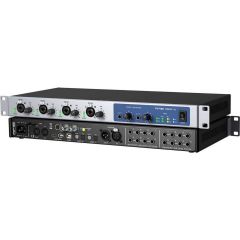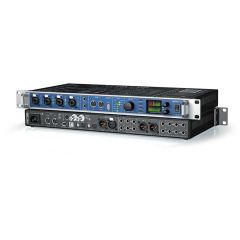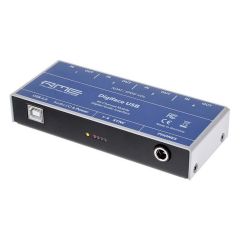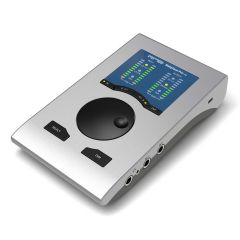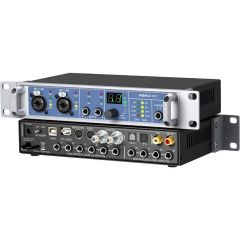Availability: Backorder
- The RME Fireface UFX III 188-Channel Audio Interface is the flagship all-in-one solution for modern recording studios and live audio playback systems.
- Seamless performance and flexibility with up to 94 channels I/O.
- Four XLR/TRS combo inputs for microphones, instruments, and line signals.
- Two stereo headphone jacks with +19 dBu output level, MIDI I/O, and a USB port.
- Expand your analogue channel count and route/mix within the digital domain through various sources.
- Record all inputs and outputs directly to USB memory devices via the front USB port with DURec, easily save your recordings and take them with you wherever you go.
RME Fireface UFX III 188-Channel Audio Interface
The Flagship Multichannel Interface
The Fireface UFX III is the ultimate multitrack studio centerpiece, delivering seamless performance and flexibility with up to 94 channels I/O. With RME's legendary low latency hardware and driver designs, DURec (Direct USB Recording), and impressive compatibility, this audio interface is built to exceed your expectations.
Designed with professional users in mind, the Fireface UFX III comes with a plethora of advanced features, including MADI I/O (64 channels), SteadyClock FS, TotalMix FX, a robust DSP, USB 3.0 (full 94 channel I/O Class Compliant ready), and support for the Advanced Remote Control USB (available separately). This makes it the go-to choice for multitrack recording, mixing, and mastering.
The Fireface UFX III is equipped with a brand-new analogue and digital board. The analogue board boasts DC-coupled analogue outputs and new AD and DA converters with improved THD+N values, while the updated high-tech components on the digital board enable exciting new features.
Powerful USB 3 Performance
The Fireface UFX III is packed with beneficial features, with an intuitive front panel that makes recording a breeze. It has four XLR/TRS combo inputs for microphones, instruments, and line signals, along with two stereo headphone jacks with +19 dBu output level, MIDI I/O, and a USB port. This USB port, in conjunction with the DURec function (Direct USB Recording), lets you record selected input and output signals (up to 80 channels) independently to a connected USB storage medium.
The rear panel of the Fireface UFX III offers a plethora of connectivity options. It features another MIDI I/O, two optical ADAT I/Os, an AES/EBU I/O, and eight balanced analog outputs with line level, including XLR stereo monitor outputs. With the new Multi-Mode, the two ADAT I/Os can function as separate optical SPDIF inputs and outputs, in addition to the AES I/O. The Fireface UFX III also includes an optical MADI interface (SC) with 64 bidirectional channels, along with Word Clock connectors (BNC) that can be used as additional coaxial MADI input and output if required.
Comprehensive MADI Connectivity
The Fireface UFX III is a game-changer when it comes to digital and analogue I/O solutions, providing access to a plethora of RME and third-party options. With the ability to expand your analogue channel count and route/mix within the digital domain through various sources, this audio interface offers an unmatched level of flexibility. You can also connect multiple external MADI devices in series, opening up even more possibilities.
The Fireface UFX III boasts some typical RME-style features to enhance MADI flexibility. For instance, even in USB 2 mode, which is limited to 30 channels I/O (12 analog plus 16 ADAT plus AES), the MADI I/O remains available via RME's integrated hardware mixer TotalMix FX. Word Clock I/O (BNC) can be switched to MADI I/O (coaxial), and a special split mode allows you to use both MADI I/Os simultaneously, with 32 channels on optical and coaxial each.
Powerful Applications for Mixing, Monitoring, and Measuring
This powerful audio interface that comes equipped with TotalMix FX DSP mixer, providing a wide range of routing and monitoring options. With the DIGICheck Analyzer, you can measure and analyze the digital data feed in both directions with unmatched precision. TotalMix FX can replace an external mixer entirely, allowing you to create multiple latency-free monitor mixes with EQ, Dynamics, Reverb, and Delay for any output, including main monitors and headphone mixes for musicians.
For even greater control, the Fireface UFX III includes TotalMix Remote, a remote control for TotalMix FX that lets you manage the hardware mixer and effects in RME audio interfaces. TotalMix Remote mirrors the current state of the host system on iPad and Windows/Mac computers in real-time, including the complete routing, all FX settings, the entire mixing state, and up to the level meters. You can easily adjust all mixer and FX settings from a distance, via Ethernet and WiFi.
DC-Coupled Outputs - CV / Gate Voltage Control
The Fireface UFX III sets itself apart from other audio interfaces with its fully DC-coupled line-level outputs. Most audio interfaces use AC-coupled outputs, which utilize capacitors to filter out low frequencies that are considered undesirable for audio. However, DC-coupling remains desirable in the world of modular synthesizers, where static or slow-moving signals are used to control various parameters such as pitch note values or LFOs.
The Fireface UFX III's DC-coupled outputs allow for the transmission of control voltages (CV) or Gate information to modular synthesizers, including popular formats like Eurorack and Moog/MOTM/Synthesizers. This functionality sets the Fireface UFX III apart from other audio interfaces and makes it an ideal tool for studio hardware and modular synth enthusiasts.
USB 3 Class Compliant Audio
The Fireface UFX III is a versatile audio interface that operates in two different modes, driver-based USB 3 and Class Compliant. The Class Compliant mode is a standard that is natively supported by operating systems like Windows, Mac OSX, and Linux distributions, making it incredibly easy to use. No proprietary drivers are required, and the device will be directly recognized when the CC firmware is loaded.
RME has taken things one step further with the Fireface UFX III by introducing full USB 3.0 support in Class Compliant Mode, making all channels available in driverless operation for Linux, Mac, and iPadOS. This feature is a first for RME audio interfaces, and it opens up a world of possibilities for recording and playback in TotalMix FX for iPad and on the system level. An iPad Pro with USB-C can manage up to 94 channels for recording and playback, providing unparalleled flexibility and performance.
ARC USB Remote Control - Plug'n Play Plus
The Fireface UFX III offers unparalleled control options, and the optional ARC USB is a must-have for anyone looking to take their audio production to the next level. The ARC USB connects to your computer via USB, allowing it to communicate with TotalMix FX directly. With 15 freely assignable and illuminated buttons, one encoder wheel, and a TS jack to connect a foot switch, the ARC USB puts full control at your fingertips.
The ARC USB is a USB 1.1 MIDI remote control designed specifically for the Fireface UFX III. Thanks to its UAC 1 class device compatibility, it is natively compatible with Windows and Mac OS X. Once the ARC USB is present in the operating system, TotalMix FX will automatically detect it and communicate with it via simple MIDI remote commands to control the UFX III.
DURec (Direct USB Recording)
With DURec, you can record all inputs and outputs directly to USB memory devices via the front USB port, making it easy to save your recordings and take them with you wherever you go. The Fireface UFX III can record on USB thumb drives or hard drives with up to 2 TB capacity, giving you plenty of storage space for your recordings.
The recording functionality is provided by the internal DSP, making it independent of a connected Windows or Mac computer. This means that you can use the Fireface UFX III as a stand-alone field recorder or a powerful multichannel live player for previous recordings, such as virtual sound checks. Live concerts, band rehearsals, or spontaneous jam sessions can be directly recorded and played back from the medium, even completely stand-alone without a computer or software.
More Outstanding Benefits
TotalMix FX - Mixing/Routing with Superior Features for Studio and Live Work
Since 2001 TotalMix added unlimited routing and mixing to RME‘s audio interfaces. Its unique capability to create as many independent submixes as output channels available turned it into the most flexible and powerful mixer of its kind.
DigiCheck - The Secret Weapon of High-Resolution Audio Measurements
RME Audio interfaces not only provide you with a professional digital audio interface but also with a free available software tool: DigiCheck, for metering, testing, measuring, and analyzing digital audio streams.
SteadyClock FS - Reference Class Digital Clocking
Excellent performance in all clock modes and High-Quality analogue conversion to hear your mix as it is, with the lowest jitter and highest jitter immunity.
RME USB - Transport Audio with Lowest Latency and Industry-Leading Stability
Use your RME audio interface on Mac and PC with reliable, stable, and regularly updated drivers for our products. RME Audio develops its own interface core, it’s not dependent on 3rd parties for upgrades, modifications, or bug fixes, so customers can use the latest operating systems without interruption or delay.
Connectivity and Features
- 12 x Analog I/O
- 4 x XLR/TRS Mic/Inst/Line
- 2 x Phones Output
- 1 x AES/EBU I/O
- 2 x ADAT I/O
- 2 x SPDIF I/O
- 1 x Word Clock I/O / MADI Coaxial
- 1 x MADI optical I/O
- 2 x MIDI I/O
- RME USB 3.0
- TotalMix FX
- ARC USB
- DURec
- Class Compliant Mode
- AutoSet Digital Gain Control
- DC-coupled Outputs
- Including FX
- SteadyClock FS
What's in the Box:
- Cable USB 3.0, 1.8 m (6 ft), USB-A/B
- Cable USB 3.0, 1.8 m (6 ft), USB-C/B
- Optical cable
- 4 rubber feet, self-adhesive
- Power cable
- Printed Manual
| Specifications | General
AnalogueAD, Line In 1-8, rear
Microphone In 9-12, frontAs AD, but:
Instrument In 9-12, frontAs AD, but:
DA, Line Out 3-8, rear
DA - Stereo Monitor Output XLR (1-2)As DA, but:
DA - Stereo Monitor Output Phones (9-12)As DA, but:
MIDI
Digital
Digital InputsMADI
AES/EBU
ADAT Optical
SPDIF optical (ADAT 2)
Word Clock
Digital OutputsMADI
AES/EBU
ADAT
SPDIF optical (ADAT 2)
Word Clock
|
|---|

 Price Match
Price Match Excellent support
Excellent support Trustpilot
Trustpilot FREE Delivery over £99*
FREE Delivery over £99* Spread payments with Klarna
Spread payments with Klarna

